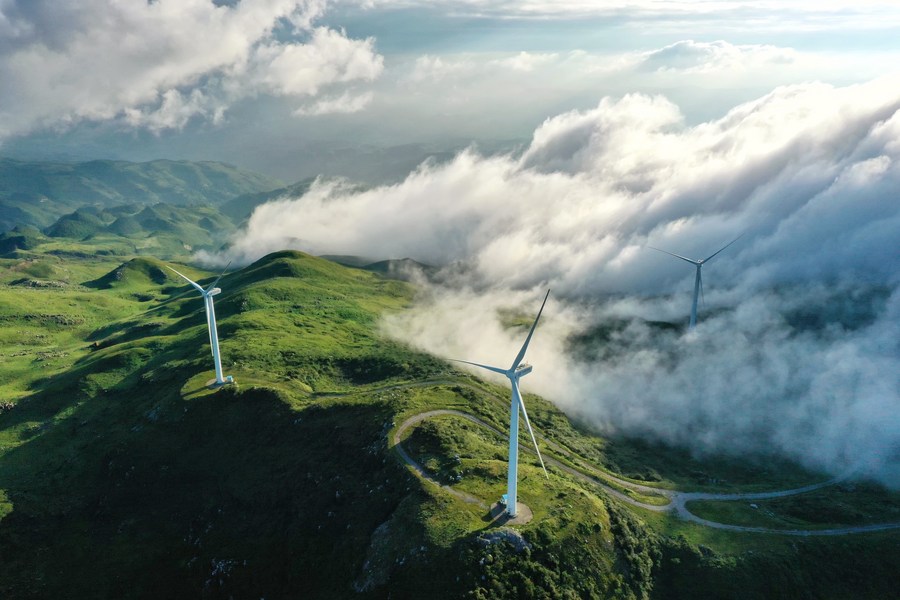Xinhua | March 14, 2023

Aerial photo taken on Aug. 19, 2020 shows wind turbines in Jiucaiping scenic spot in southwest China's Guizhou Province. (Xinhua/Liu Xu)
Lucid waters and lush mountains are invaluable assets.
This philosophy for green and sustainable development has well depicted one of the defining features of China in the new era. It means that Beijing, when pushing forward China's development, is committed to maintaining harmony between humanity and nature.
Under such a guideline, China's green transition is rapidly gaining momentum, from developing non-fossil energy to updating the industrial structure, from investing in low-carbon technologies to transforming the transport sector.
What has China achieved in its green shift? How is it benefiting both China's industries as well as others around the world in terms of environmental protection and development opportunities?
LOW CARBON
China has established a carbon neutralization working mechanism to implement the "dual carbon" goal, which is to peak carbon dioxide emissions before 2030 and achieve carbon neutrality before 2060. It has clarified the top-level design of the "dual carbon" work, and formulated implementation plans in energy, industry, transportation as well as other key areas.
Over the past years, China has taken concrete steps to optimize its energy mix, in which renewable energy has played a more significant role.
Data show that the installed capacity of renewable energy has surpassed one billion kilowatts, accounting for 44.8 percent of China's overall installed capacity. The installed capacity of hydropower, wind power, and photovoltaic power each exceeded 300 million kilowatts, all ranking the highest in the world, according to a white paper titled China's Green Development in the New Era, released by China's State Council Information Office in January.
From 2012 to 2021, China's annual energy consumption growth rate of 3 percent supported an average economic growth rate of 6.6 percent, carbon dioxide emissions per unit of GDP decreased by about 34.4 percent, and energy consumption per unit of GDP decreased by 26.4 percent, with a cumulative saving of 1.4 billion tons of standard coal.
In 2021, China's national carbon market officially launched online trading, covering 4.5 billion tons of greenhouse gas emissions annually, making it the world's largest carbon market. It has encouraged companies to reduce their carbon emissions by putting a price on carbon, and drive the development of low-carbon technologies.
China's low-carbon strategy was laudable, said Phay Siphan, Cambodian government's chief spokesman. "It truly demonstrates China's commitment to promoting global carbon emissions reduction and green development."
OPPORTUNITIES FOR EVERYONE
Green is the new gold. As China is transitioning towards a greener development mode, low-carbon industries in the country have been flourishing in recent years, which has spawned more business opportunities for enterprises worldwide.
The new energy vehicle (NEV) industry is a fine illustration. Last year alone, China sold about 6.89 million NEVs, skyrocketing 93.4 percent year on year. NEV production soared 96.9 percent from a year earlier to about 7.06 million units. The market share of NEVs in China's auto market reached 25.6 percent in 2022, up 12.1 percentage points from 2021.
Thanks to China's thriving NEV market, Mercedes-Benz increased its deliveries of NEVs by 143 percent year on year in 2022. Hubertus Troska, member of the board of management of Mercedes-Benz Group AG responsible for Greater China, said last month that the German carmaker will continue to invest more in China.
"We will expand our layout of R&D and industry chain and accelerate our innovative transformation towards electrification, digitalization, and carbon neutrality to meet the upgrading luxury mobility needs of Chinese customers," Troska said in an interview with Xinhua.
Citing China's ever-growing portion of the global electric vehicle market, Leslie Maasdorp, vice president and chief financial officer of the New Development Bank, said China can play a crucial role in stimulating the low-carbon growth strategy of the world economy.
A SHARED GREEN FUTURE
Domestically, China's green transition is bringing a real change. Globally, it is also helping other countries to sustain green growth.
In the mostly arid, desert-capped Kenyan county of Garissa, a China-financed solar power plant, the largest solar plant in East and Central Africa, has set Kenya on the path of achieving green energy sufficiency, and brought benefits to thousands of families and businesses since 2019.
"China is the largest supplier of solar energy equipment across the world and in Africa in particular," said Ajay Mathur, director general of the International Solar Alliance.
While noting that many solar panels and batteries being used in Africa are of Chinese origin, Mathur underscored China's involvement and huge potential in terms of realizing Africa's quest for solar energy development.
"There is the greatest linkage that exists between the Chinese manufacturers of solar energy technology and the African users of that technology," he said.
Apart from African countries, China is also sharing its green development philosophy with many more countries across the globe. The Chilean capital of Santiago has been tapping electric vehicles from China as part of plans to revamp its public transport system and advance clean mobility.
While boosting development, maintaining biological diversity is also emphasized. For example, many tunnels were extended and roads replaced by bridges to protect elephant habitats in the construction of the China-Laos Railway.
"The contribution of China's green development to global sustainable development cannot be ignored, and it also sets an example for other countries' green development," said Abdulrahman Aldakhil, director of Corporate Communication of Saudi National Center for Vegetation Cover Development Combating Desertification.
"China's promotion of international cooperation to protect the environment is a manifestation of its sense of responsibility," he said. "China's experience in green development is worth learning from."

